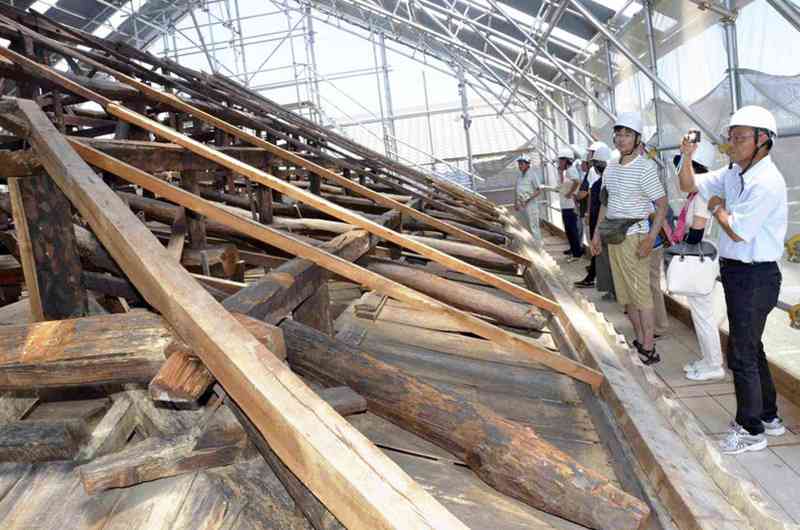
“Black Cat” (1910) by Shunso Hishida. This important cultural property needs to be refinished due to paint peeling off and small bumps on its back.
11:12 JST, January 12, 2022
Crowdfunding and the so-called “hometown tax” donation system, are increasingly being used to pay for the repair of cultural properties that have deteriorated over time.
The full cost of such repairs is not covered by subsidies, even for cultural properties so designated by the central or local governments. This has placed a heavy burden on the owners amid the severe economic situation primarily caused by the novel coronavirus pandemic.
“We can’t just ignore the future damage to our cultural properties,” read a message from the Eisei Bunko Museum in Bunkyo Ward, Tokyo, on a special page of a crowdfunding website. The museum displays artifacts related to the Hosokawa family, former lords of the Kumamoto domain.
The Eisei Bunko Museum has a collection of masterpieces of modern Japanese painting, including the national important cultural property “Black Cat” by Shunso Hishida (1874-1911). Money is needed to restore the works, some of which have paint flaking off and stains.
The museum closed for about three months in 2020, and it has had few opportunities to lend its masterpieces to other museums, due to the pandemic. In the midst of declining revenue from museum admissions and lending fees, the museum participated in crowdfunding in July, offering such rewards for donations as access to an online lecture by the museum’s curators and a special pouch.
The museum reached its target of ¥10 million in September, ultimately collecting ¥14.75 million. A museum official in charge of the project said: “We received a stronger response than we expected. We want to share our progress with the donors and are considering showing the repair process to the public.”
The Tokyo National Museum in Taito Ward, Tokyo, had 89 national treasures and 648 important cultural properties as of April. It also has many cultural properties in need of restoration and urgently needs funding for that. Many Japanese cultural properties are made of delicate materials such as silk and Japanese paper, and are susceptible to environmental changes.
“Fuyuki Kosode” is a kimono with an autumn grass pattern drawn by Ogata Korin (1658-1716), an artist of the Rimpa school of Japanese painting. Designated as an important cultural property, it has become noticeably stained and has broken threads. Money to repair the kimono was collected through crowdfunding, donation boxes at the museum and sponsors’ cooperation, ultimately reaching the target of ¥15 million.

Hojo, the main building of Daruma-ji temple, in Oji, Nara Prefecture, in 2018
Donations supplement costs
Some local governments have used the hometown tax donation system to repair cultural properties. Oji, Nara Prefecture, dismantled and repaired Hojo, the main building of the Daruma-ji temple that has been designated as a cultural asset by the prefectural government. Daruma-ji is an ancient temple associated with Prince Shotoku, considered one of the key figures in Japan’s political history.
The town subsidized 20% of the total repair costs, using money donated via the hometown tax system.
“Repairing cultural properties is a heavy burden, not only for the owner but also for the local government that provides subsidies,” a town official said. In Oji’s case, the town government limited the purpose of donations to repairing Hojo and other cultural properties. This strategy succeeded in gaining the sympathy of history buffs, collecting about ¥167 million.
Cultural properties need to be repaired at appropriate intervals. Buildings should undergo fundamental repairs once every 150 years, and fine arts and crafts need full-scale restoration work once every 50 years.
For nationally designated cultural properties, the government subsidizes half of the repair costs in principle. The figure rises up to 85% depending on the scale of the repairs and other factors, meaning that owners have to pay for some portion of the costs.
However, the number of parishioners who are expected to support temples and shrines financially is declining due to depopulation and aging. Museums are facing a drop in visitors due to the pandemic.
In 2020, the Cultural Affairs Agency issued a handbook describing successful examples of repairs through crowdfunding and hometown tax donations. These include a temple that went public with its efforts to preserve and repair cultural properties, and a traditional machiya-style building in Kyoto that uses its facilities partly as accommodations, using entry and accommodation fees to cover repair and maintenance costs.
The government’s Takumi Project for Cultural Properties, an initiative that aims to strengthen the system to repair cultural properties from fiscal 2022 onward, is expected to focus on a diverse range of funding options, including donations.
Akira Matsuda, an associate professor of the University of Tokyo who specializes in cultural resources, said: “The need to diversify funding sources for repairs has increased due to the novel coronavirus pandemic. The spread of online events increased the opportunities to send information, and there are good examples of skillfully presenting the stories behind cultural properties through video and other means. I hope these successful cases will be widely shared and more options will become available to suit the circumstances of owners.”
"Society" POPULAR ARTICLE
-

M4.9 Earthquake Hits Tokyo, Neighboring Prefectures
-

Israeli Tourists Refused Accommodation at Hotel in Japan’s Nagano Pref., Prompting Protest by Israeli Embassy and Probe by Prefecture
-

M7.5 Earthquake Hits Northern Japan; Tsunami Waves Observed in Hokkaido, Aomori and Iwate Prefectures
-

Tsukiji Market Urges Tourists to Avoid Visiting in Year-End
-

M5.7 Earthquake Hits Japan’s Kumamoto Pref., Measuring Upper 5 Intensity, No Tsunami Expected
JN ACCESS RANKING
-

Tokyo Economic Security Forum to Hold Inaugural Meeting Amid Tense Global Environment
-

Keidanren Chairman Yoshinobu Tsutsui Visits Kashiwazaki-Kariwa Nuclear Power Plant; Inspects New Emergency Safety System
-

Imports of Rare Earths from China Facing Delays, May Be Caused by Deterioration of Japan-China Relations
-

University of Tokyo Professor Discusses Japanese Economic Security in Interview Ahead of Forum
-

Japan Pulls out of Vietnam Nuclear Project, Complicating Hanoi’s Power Plans























